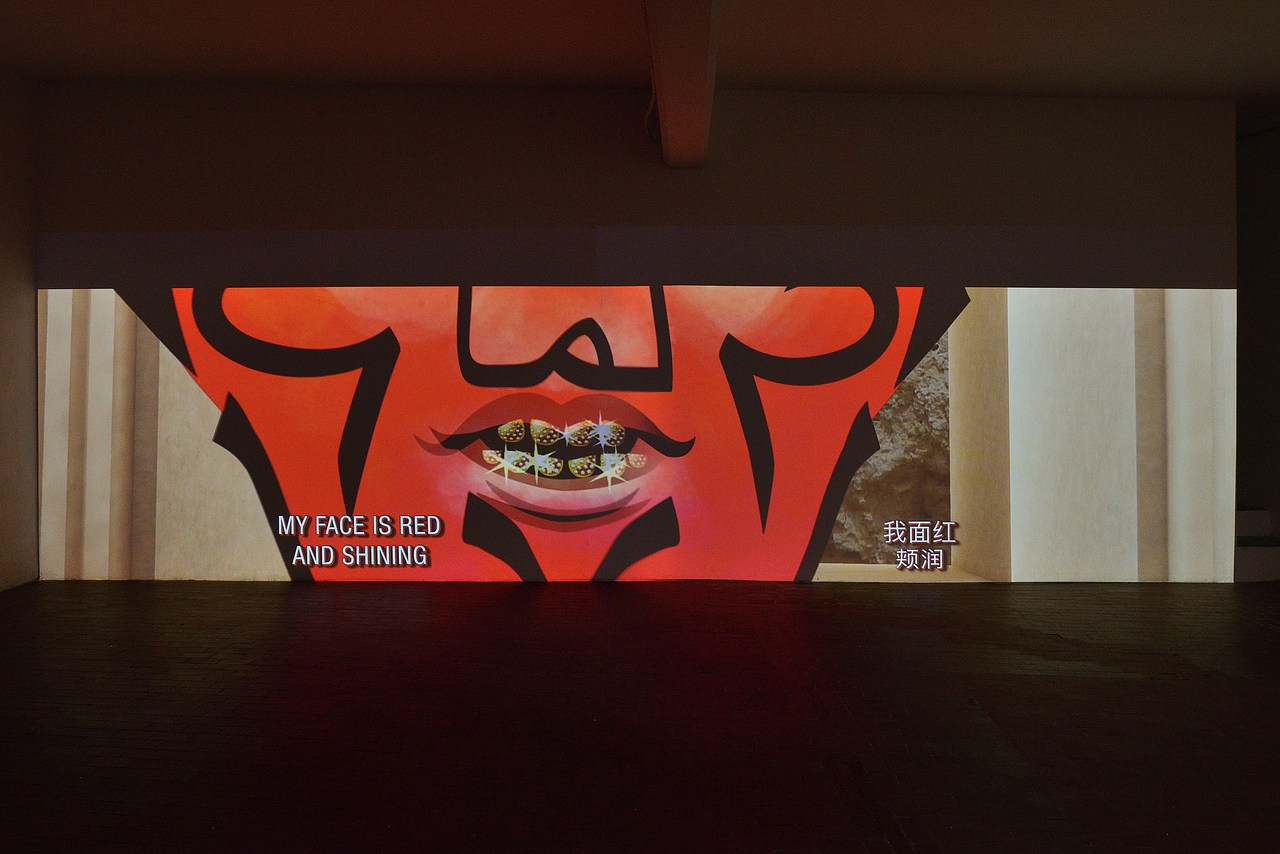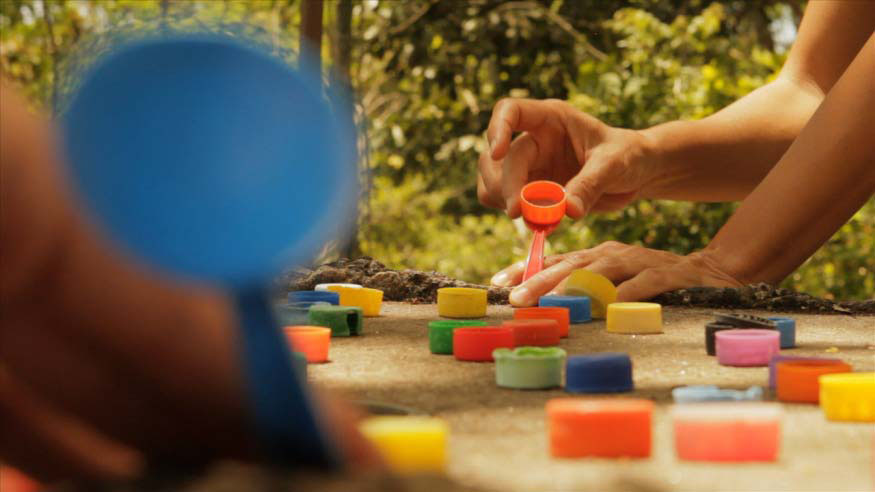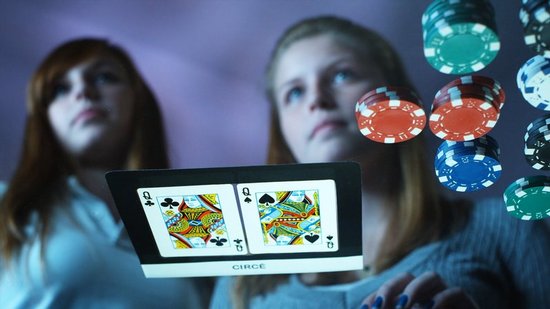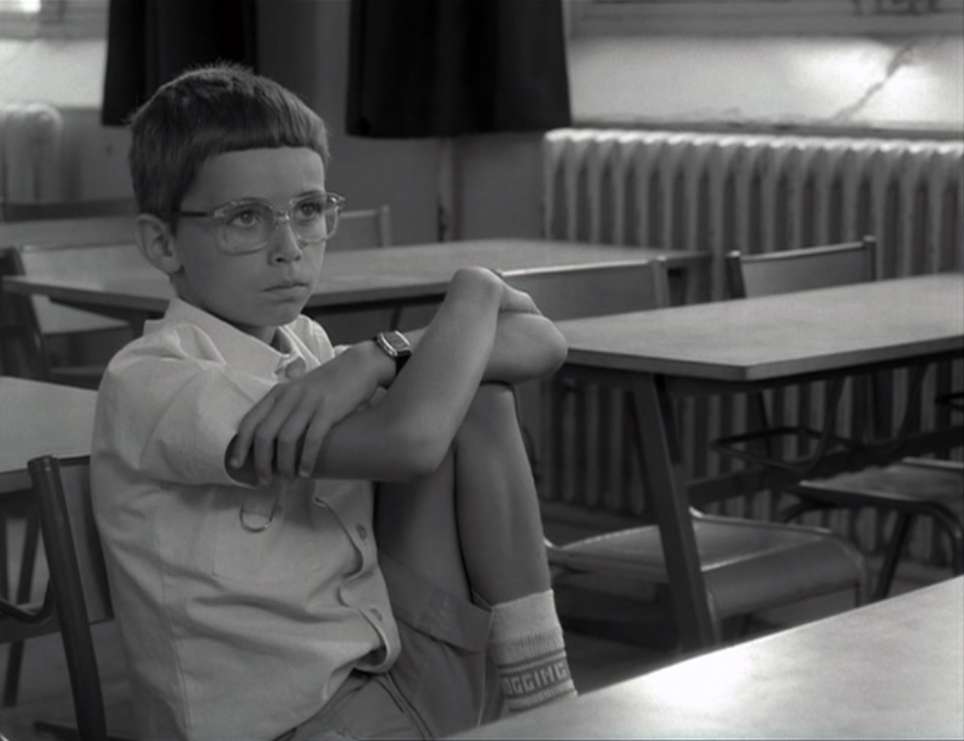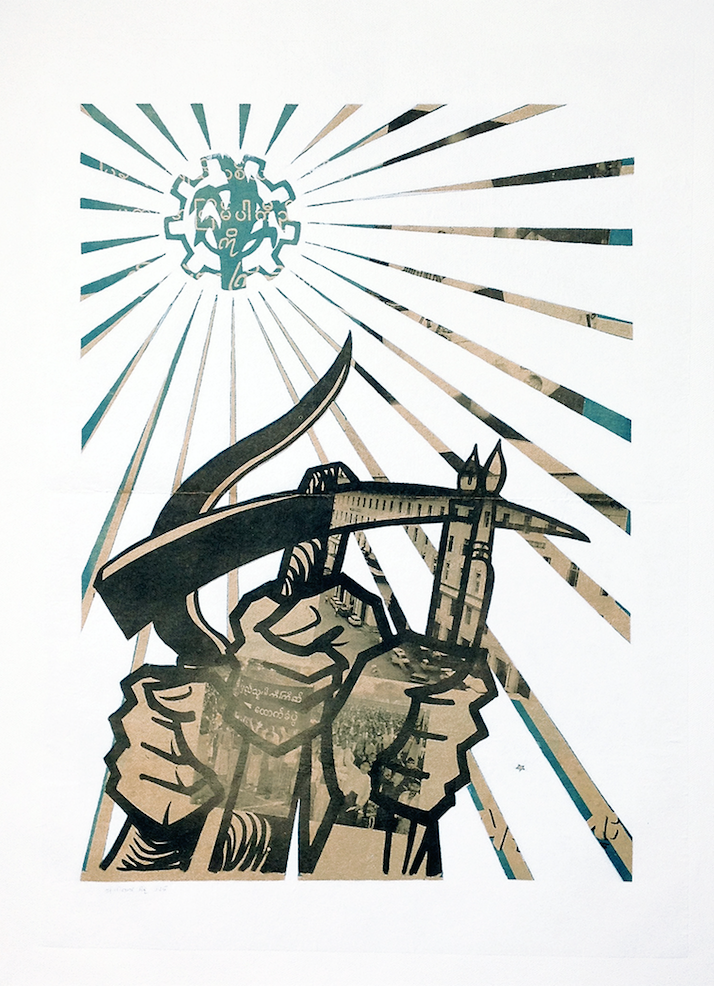
© » KADIST
Ana Teresa Fernández
Drawing & Print (Drawing & Print)
The artist writes about her work Borrando la Frontera, a performance done at Tijuana/San Diego border: “I visually erased the train rails that serve as a divider between the US and Mexico. I painted them sky blue, creating a “Hole in the Wall” This deconstruction of “feminized” work explores the difficulties in reconciling both low wages and undervalued work via social and political infrastructures, confronting issues of labor and power. The images that I myself perform, present a duality: women dressed in a black tango dance attire while engaging in de-skilled domestic chores; the surreal within non-fiction.

© » KADIST
Miguel and Natalia Fernández de Castro and Mendoza
The Absolute Restoration of All Things is a collaboration by artist Miguel Fernández de Castro and anthropologist Natalia Mendoza. For this project, Fernández de Castro and Mendoza researched the 2014 court case that shut down Penmont Mining’s operations in the middle of the Sonoran desert. The lawsuit was brought to court by the “ejidatarios” (communal land holders) of El Bajío, Sonora, who claimed that their territory was illegally occupied and exploited, causing an irrevocable environmental impact on their land.
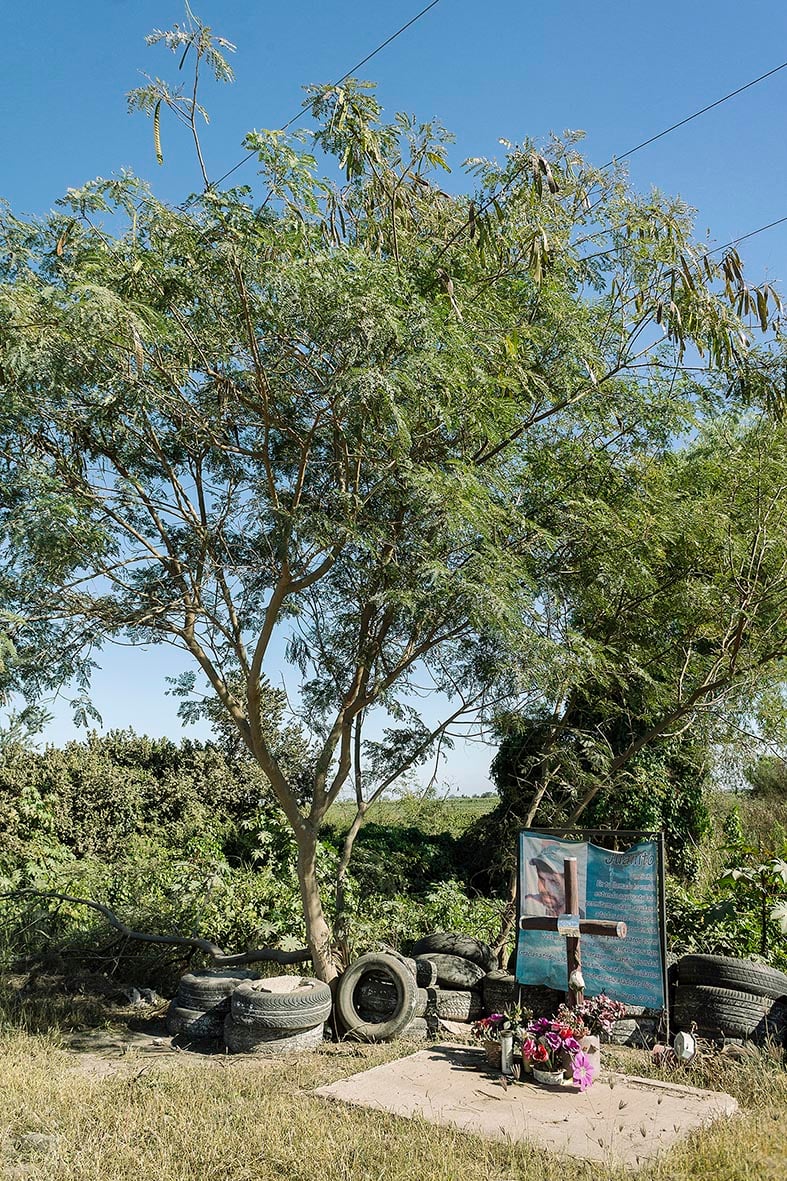
© » KADIST
Teresa Margolles
Stretching between San Pedro and the beach in Altata, Sinaloa, there is a 40 km road where there are three invisible borders controlled by rivalling armed groups. There is a price to pay for crossing these territories. This series of 21 photographs by Teresa Margolles, titled 40 Km , resemble snapshots of peaceful lands, but also bear witness to the reality lived by the local people in this area.
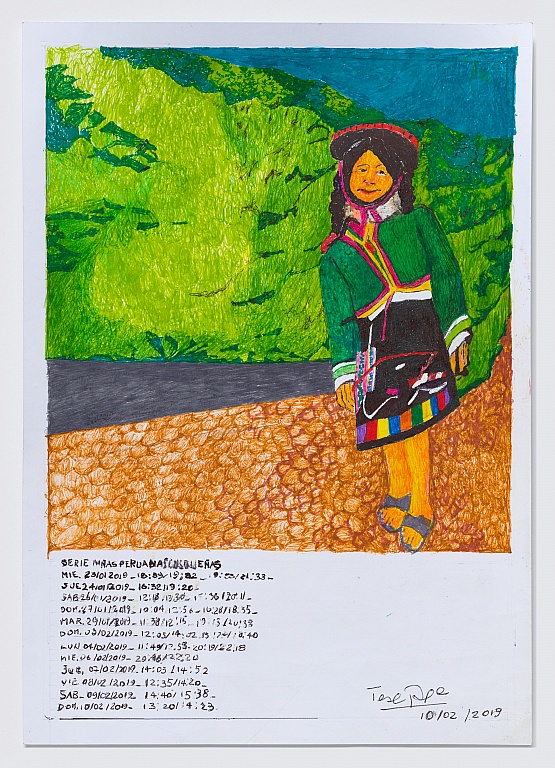
© » KADIST
Teresa Burga
Drawing & Print (Drawing & Print)
In her new series titled Ninas Peruanas Cusquenas , Teresa Burga depicts young indigenous women from Peru’s Andean region, dressed in traditional garments. Sourcing imagery from the internet, the drawings recall an untitled series of drawings from 1974, in which Burga selected images of women at random from various print media, and then rendered the images on paper. Those drawings, like the newer ones, suggest the perils of images without context––how assumptions are made, stereotypes are formed, and knowledge is gathered.
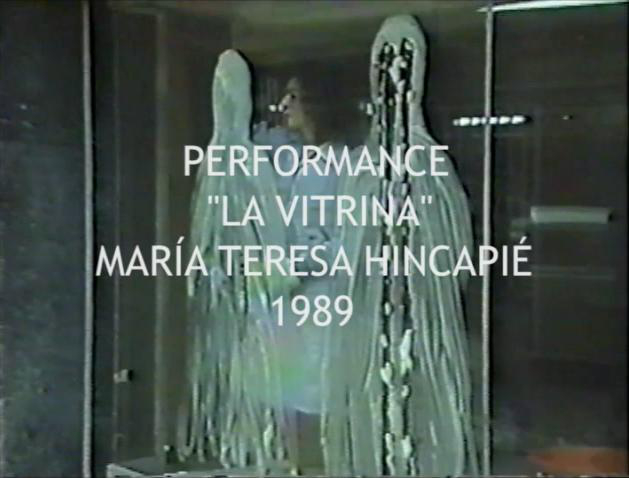
© » KADIST
María Teresa Hincapié
In the performance video Vitrina , María Teresa Hincapié stood inside a storefront window in downtown Bogota, unannounced, for eight hours a day, wearing a uniform and initially carrying out cleaning chores. As the day and passers went by, the routine became more playful: she would send kisses to bus drivers on the busy Avenida Jiménez who would return them, use the newspaper with which she was shining the glass to flirtatiously hide and engage with an improvised audience or draw the shape of her body with soap and a sponge. She would interrupt these chores to carry out other ‘feminine’ activities, like brushing her hair or applying make-up, only to return to frantically cleaning the transparent surface that separated her from the public.

© » KADIST
Carlos Fernández
Part of the exhibition PIÑA MATRIZ (2014) at Despacio Art, this untitled work by Carlos Fernández is a wood panel (formerly a section of a wooden table top) that bears the residue of insects interacting with fermented pineapple. The exhibition considered the production of pineapple monocultures and the agricultural monopolies for this product. Fernández used the exhibition space to portray alternative possibilities of diversified and ecologically sustainable production that could be mobilized in place of mass produced pineapple monocultures.

© » KADIST
Fernanda Gomes
For this floor based work, Gomes has taken two lengths of bamboo and tied them together using linen thread. The work is self-supporting and stands in a crack or a hole in the floor. The work suggests precariousness, frailty as well as humanity through its verticality, and its gentle sinuous form, referencing perhaps the work of Giacometti.

© » KADIST
Jonathan Hernández
In line with Hernández’s interest in catastrophe, Vulnerabilia (choques) is a collection of images of shipwrecks and Vulnerabilia (naufragios) collects scenes of car crashes. The artist has said that the appropriation of popular imagery is a way for him to take pictures without a camera and to register the things that happen in the everyday as visual essays that evidence the fragility of the world.

© » KADIST
Maria Fernanda Plata
Unraveling, or “unweaving” sections of fabric, Maria Fernanda Plata arrived at delicate and tenuous-looking forms, both ghostly and gentle. Her careful meditations in fabric reflect Plata’s ongoing interest in the relationship between people and their environments, in fragility, systems, and destruction.

© » KADIST
Tessa Mars
In this untitled acrylic painting, Tessa Mars explores the long-lasting effects of colonialism on the Afro-Caribbean diaspora, particularly in terms of female vulnerability and resilience. Drawing on her interest in retelling stories of her native country, and confronting the past and the present, Mars portrays her cultural essence and heritage by imagining spiritual spaces that connect people and land across time. With a pictorial practice that highlights pastel colors, the divinisation of the figures on the canvas and the spiritual elements within the composition ultimately enhance the narrative of her Caribbean ancestry while conflating the distinctions between autobiographical and historical events.

© » KADIST
Ana Vaz
Há Terra! (There Is Land!) is a short film by Ana Vaz that picks up on the artist’s previous film A Idade da Pedra (2013), in which Vaz imagined premodernity in her native Brazil.

© » KADIST
Fernanda Laguna
Llorar mucho (To Cry A Lot) is representative of Fernanda Laguna’s practice of the past twenty years. It is an upshot of intense emotional stress and psychological regression for the artist, which resulted in her renewed and strengthened commitment to feminist causes, especially in Villa Fiorito, but also as part of the leading committee of Ni Una Menos in Argentina. It also picks up the thread of earlier works, accentuating the use of cotton, and embracing an almost cornily sentimental tone.

© » KADIST
Fernanda Laguna
¡Qué triste estoy! (I’m So Sad) is representative of Fernanda Laguna’s practice of the past twenty years. It is an upshot of intense emotional stress and psychological regression for the artist, which resulted in her renewed and strengthened commitment to feminist causes, especially in Villa Fiorito, but also as part of the leading committee of Ni Una Menos in Argentina.

© » KADIST
Rajni Perera
Drought Mask by Rajni Perera is a prototype that is suggestive of dire implications for human survival. Directly addressing the urgent climate crisis, specifically wide-spread drought, this sculpture imagines hybrid cultural aesthetics of the near-future after global collapse. Composed of various woven textiles complete with frills and fringes, leather, a gas mask, and pencil, Rajni’s mask prefigures future dystopian characters who are resilient and resourceful; self-fashioning tools for survival.

© » KADIST
Ron Terada
Drawing & Print (Drawing & Print)
The three Maiko s were included in Ron Terada’s 2008 exhibition, Voight–Kampf , at Catriona Jeffries gallery. More ambitious in size and subject matter, this show with its complex video installation marked a new path for Terada’s work. Voight-Kampf is based on a scene from Ridley Scott’s 1982 movie Blade Runner in which a giant advertising billboard in the midst of a dystopian city of Los Angeles in the future displays a geisha eating candy.

© » KADIST
Alejandro Almanza Pereda
This still life falls apart, or rather floats apart as the composition is proved unstable and constantly morphing. An impossible attempt at achieving a fixed state, some objects remain buoyant and some objects sink, constantly tilting the overall scale and arrangement. Properties of weight, mass and shape have their own will but a hand appears in the scene, pushing back on these mysterious forces.

© » KADIST
Ana Navas
Ana Navas uses humor to address formal, aesthetic, and societal conventions that are interwoven in the everyday through the normalization of gendered behaviors and style choices used to project personal and collective signifiers. In her Donation Vases she uses quotes taken from corporate coach Lois P. Frankel’s book Nice girls (still) don’t get the corner office: Unconscious Mistakes Women Make That Sabotage Their Careers (2004). The aspirational, somewhat cynical tone of the sentences – “When given a choice, sit next to most powerful person, their power will cascade over you,” “Why is it that women buy those little chains to hang reading glasses around their necks,” “If you see your reflection on a glossy surface & notice something wrong, avoid fixing it there” – reveals a particular understanding of what a professional, ambitious cis woman should look like, the persona she should project, and the type of desirable behaviors that constitute a stereotypical “successful woman” according to a capitalist morality.

© » KADIST
Ana Vaz
Ana Vaz describes her film É Noite na América (It is Night in America) as an eco-terror tale, freely inspired by A cosmopolitics of animals by Brazilian philosopher Juliana Fausto; in which she investigates the political life of non-human beings and questions the modern idea of the exceptionality of the human species. In parallel to the feature film version, Vaz created a three-channel installation format meant to be displayed in contemporary art spaces. This edition includes three complementary video works that expand on the conceptual frameworks of the film.

© » KADIST
Ana Roldán
Ana Roldán’s Primeval forms series looks up close at the fecund shapes of plants often found in the artist’s native Mexico. These botanical portraits, like this one of the Pseudobombax ellipticum, or shaving brush tree, bristle against the edges of the image’s frame, fecund and wild, familiar yet foreign. Ana Roldán works in diverse media such as performance, sculpture, installations, video and collage.
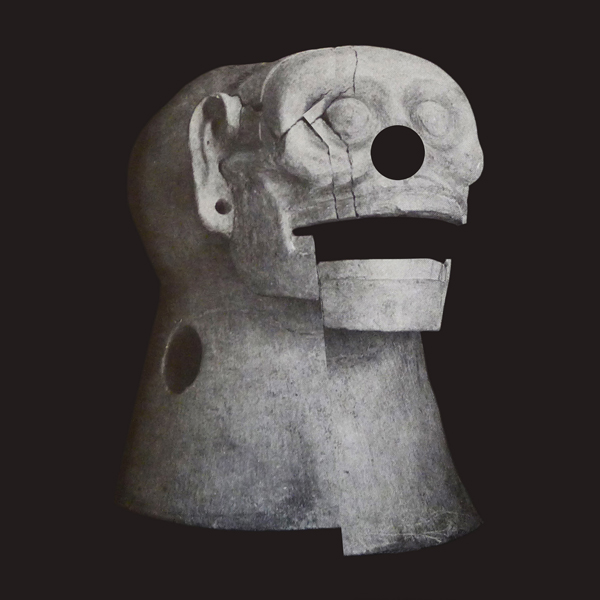
© » KADIST
Ana Roldán
Ana Roldán’s Displacements works use images taken from a 1970s exhibition catalogue for an exhibition called The Death in Mexico. Using pre-Columbian objects and other artifacts from Mexican history, the exhibition aimed to explore various representations of death in the Mexican cultural tradition. Roldán’s works begin with these rich black-and-white photographs and break them apart into fragments, slicing and dismembering the artifacts they depict.

© » KADIST
Fernando Palma Rodríguez
Aqua by Fernando Palma Rodríguez is an installation formed by four gourds and one movement detector that activates them. Once put in motion, the gourds open and close hinged hands that are cut from their bodies, catalyzing a sophisticated, choreographed conversation among them. Following Indigenous notions of personhood, Palma Rodríguez grants agency to ordinary objects and therefore the ability to relate to others—humans as well as non-humans.
![Elevación [Elevation]](https://kadist.org/wp-content/uploads/2022/09/IMG_escena001_3513-scaled.jpg)
© » KADIST
Ana María Millán
Interested in role-play and videogames, Ana María Millán developed workshops with different communities in order to create characters and scenarios for her animations, often in collaboration with a choreographer. Elevación evokes various narratives inspired by the comicstrip Marquetalia, Raíces de la Resistencia (Marquetalia, Roots of the Resistance) (2011). This comic strip is a memoir of the FARC (Revolutionary Armed Forces of Colombia) guerillas written by Jesús Santrich, one of its leaders who, after the 2016 Peace Agreement, rejoined dissident members of the organization in a clandestine guerrilla splinter group in 2019.

© » KADIST
Hana Miletic
Incompatibles (Unitas) is made from discarded samples of the yarns that are exported from Croatia and not actually available in the local market. The textile industry in former Yugoslavia has essentially closed down under pressure from Indian and Chinese industries and as a result of the botched privatization of once state-owned factories. There is only one factory remaining in Zagreb producing these yarns.

© » KADIST
Anna Boghiguian
In the painting called “The Consciousness of Memory, Time, and Guilt” as in many of her recent works, the body is fragmented. The brain, the ear, the eyes, these body parts that put us in relation with the other and link the visible to the invisible, remain isolated. Whereas the skulls are joined by lines evoking rivers.

© » KADIST
Dana Kavelina
Letter to a Turtledove by Dana Kavelina is a short film based on a poem written by the artist. Delivered as a monologue and presented with subtitles, the poem encapsulates the traumas, grievances, horrors, dreams, and hallucinations that have descended upon Ukraine’s Donbass region since its invasion by Russia in 2014. Appropriating amateur footage shot during the war in the Donbass region, Kavelina’s film weaves sound and image into a poignant tapestry that considers the absurdity of war.

© » KADIST
Anna Molska
Perspective was filmed during a residence in northern Poland. The film is preceded by a series of photographs made ? ?in her studio.

© » KADIST
Jordan Ann Craig
Something To Do With Being Held by Jordan Ann Craig is inspired by a Cheyenne bead bag. Intrigued by the two shades of blue used for the source object (a deep dusty blue and a bold vivid cobalt blue) the artist replicated these shades in her painting. Craig then added in her own colors, including the pink-orange hues, to achieve a bold but soft quality about the work, as she states that she intended the work to convey vulnerability.

© » KADIST
Gabriella and Silvana Mangano
There is no there by Gabriella and Silvana Mangano is a black and white looped video with sound, in conjunction with a live performance. The work is inspired by the Blue Blouse, a political propaganda theater movement which spread across the Soviet Union in the mid-1920s. More specifically, the work takes the form of ‘Living Newspapers’, which were performances based on topical news events.

© » KADIST
Mary Ann Aitken
Untitled (Boom Box, Double-Sided) by Mary Ann Aitken is representational painting of a boom box on an unconventionally long canvas painted on both sides, to mimic the scale and appearance of the actual appliance. Known for going against trends, Aitken often favored dimensions, such as the square, that were otherwise considered out of style in contemporary painting. In this double-sided painting, one side depicts the titular boombox set up—a boxy cassette player, flanked by a pair of stereo speakers in front of wood panelling.

© » KADIST
Mary Ann Aitken
Untitled (Diptych) by Mary Ann Aitken is a pair of paintings; one entirely abstract and the other a hybrid of representational and abstract elements. The left-side painting is a cacaphonous all over composition of brushstrokes layered in the artist’s signature primary colors. In the same color scheme, the right-side painting portrays a still life with an arrangement of flowers as its focal point, with marks and splatter spilling from the left-side composition into the right.
Chantal Edie and Zacharie Ngnogue
Chantal Edie and Zacharie Ngnogue are a photography duo who channel their personal experiences into social commentaries...
An-My LE
- location: New York, New York
- year born: 1960
- gender: female
- home town: Saigon, Vietnam
Ana Vaz
Ana Vaz is an artist and filmmaker whose works speculate on the relationships between self and other, and myth and history, through a cosmology of signs, references, and perspectives...
Fernanda Laguna
Fernanda Laguna has mobilized and influenced a whole generation of artists through her various projects since the mid-1990s...
Mary Ann Aitken
Mary Ann Aitken was known to be very private about her art practice; she was considered somewhat of an outsider by her peers affiliated with the second wave of Detroit’s Cass Corridor arts movement...
John Wood and Paul Harrison
John Wood and Paul Harrison have been working collaboratively since 1993, producing single screen and installation-based video works...
Leung Chi Wo and Wong Sara
Leung Chi Wo tends to highlight in his art the boundaries between viewing and voyeurism, real and fictional, and art and the everyday...
Ho Rui An
The artist, writer, and researcher Ho Rui An probes histories of globalization and governance, performing a detournement of dominant semiotic systems across text, film, installation, and lecture...
Etel Adnan and Lynn Marie Kirby
Visual artist, poet, and essayist Etel Adnan writes what must be communicated through language, and paints what cannot...
Donna Conlon and Jonathan Harker
- location: Panama City, Panama
- year born: 1966
- nationality: American and Ecuadorian
Jordan Ann Craig
Jordan Ann Craig is a Northern Cheyenne artist born and raised in the Bay Area; she invests her work with a strong interest in Indigenous culture and the history of its destruction by settlers...
Maayan Amir and Ruti Sela
Maayan Amir and Ruti Sela, two young Israeli women artists work collaboratively or individually by project...
Michelle and Noel Keserwany
Michelle and Noël Keserwany compose and perform their own songs, as well as contribute to the illustrations and animations featured in the videos they produced...
Tessa Mars
Tessa Mars delves into Haitian history, her primary source of inspiration, to unveil a colourful and provocative universe that she wishes to reclaim...
Lenka Clayton and Phillip Andrew Lewis
Lenka Clayton and Phillip Andrew Lewis’s collaborative practice is social at its core: it engages with and connects communities outside of the so-called art world in both production and presentation...
Pooja Gurung and Bibhusan Basnet
Pooja Gurung and Bibhusan Basnet have a joint practice that merges film and visual art...
Rajni Perera
Rajni Perera’s practice foregrounds a hybrid model that merges immigrant politics, feminine power, mythology, and science fiction...
Fernanda Gomes
- location: Rio de Janeiro, Brasil
- year born: 1960
- gender: female
- nationality: Brazilian
Gabriella and Silvana Mangano
Gabriella Mangano and Silvana Mangano are an artistic duo and identical twins known for their collaborative and performative video practice...
Ron Terada
Ron Terada belongs to a generation of Vancouver-based artists that follows the well-known Vancouver School of photoconceptualists which includes Jeff Wall, Stan Douglas, and Ian Wallace...
Olive Martin and Patrick Bernier
Patrick Bernier and Olive Martin are a duo of artists collaborating since 1999...
Jane Jin Kaisen and Guston Sondin-Kung
Working with narrative experimental film, multi-channel video installation, performative video art, photography, and text, Jane Jin Kaisen engages themes of memory, trauma, migration and translation at the intersection of personal and collective histories...
Musquiqui Chihying and Gregor Kasper
Through his artistic career, Musquiqui Chihying has striven to dislocate and reconstruct established modes of behavior within systems and structures of power...
Ei Arakawa and Sergei Tcherepnin
Ei Arakawa and Sergei Tcherepnin began their audio-visual and performative collaboration in 2007...
The Propeller Group and Superflex
The Propeller Group was established in 2006 as a cross-disciplinary structure...
Raimond Chaves and Mantilla Gilda
The collaborative works of Raimond Chaves and Mantilla Gilda often derive from a direct engagement with the world...
Alejandro Almanza Pereda
Alejandro Almanza Pereda has a heightened understanding of the essence of objects...
Anna Molska
Anna Molska uses video performance to explore the effect of artistic culture on the production of art...
Jonas Van and Juno B
Although Jonas Van and Juno B do not belong to a collective, this collaborative video reflects their individual practices and their complex subjectivities...

© » APERTURE
about 5 months ago (12/01/2023)
For the past two decades, An-My Lê has used photography to examine her personal history and the legacies of US military power, probing the tension between experience and storytelling....
-
1980-1989
Jean-Marie Straub and Danièle Huillet
1982En rachâchant is based on the short story Ah! Ernesto! (1971) by Marguerite Duras in which the child Ernesto does not want to go to school anymore as all that he is taught are things he does not know...
María Teresa Hincapié
1989In the performance video Vitrina , María Teresa Hincapié stood inside a storefront window in downtown Bogota, unannounced, for eight hours a day, wearing a uniform and initially carrying out cleaning chores...
-
1990-1999
John Wood and Paul Harrison
1996One of John Wood and Paul Harrison’s earliest works, Device features Harrison performing a series of actions, assisted by the titular ‘devices’, that use physics to force his body into unusual and uncomfortable positions...
John Wood and Paul Harrison
19973-Legged is an early video work by John Wood and Paul Harrison in which they appear with their legs tied together (as one would do in a three-legged race)...
-
2000-2009
Mary Ann Aitken
2002Untitled (Boom Box, Double-Sided) by Mary Ann Aitken is representational painting of a boom box on an unconventionally long canvas painted on both sides, to mimic the scale and appearance of the actual appliance...
Maayan Amir and Ruti Sela
2003In Beyond Guilt the two artists create a portrait of our generation in three parts...
Jonathan Hernández
2008In line with Hernández’s interest in catastrophe, Vulnerabilia (choques) is a collection of images of shipwrecks and Vulnerabilia (naufragios) collects scenes of car crashes...
Ron Terada
Drawing & Print
2008(Drawing & Print) The three Maiko s were included in Ron Terada’s 2008 exhibition, Voight–Kampf , at Catriona Jeffries gallery...
Mary Ann Aitken
2009Untitled (Diptych) by Mary Ann Aitken is a pair of paintings; one entirely abstract and the other a hybrid of representational and abstract elements...
Jay Chung and Takeki Maeda
2009Jay Chung and Q Takeki Maeda remake a clip from the 1970s they found on the internet, and without really changing this archive material, displace it by imitating the staging and the acting with scrupulous precision...
Pauline Boudry and Renate Lorenz
2009Salomania sees choreographer and filmmaker Yvonne Rainer and artist Wu Tsang rehearse scenes from Valda’s Solo , a chapter of a film Rainer made in 1972 after having seen women perform the dance of the seven veils in Alla Nazimova’s 1923 silent film Salomé ...
-
2010-2019
Olive Martin and Patrick Bernier
2010The Mohawk, the emblematic Frontier river in the period of American colonisation, is here a cable of data transmission, and the 7 Sultans Casino is a virtual destination, one of the three hundred online casinos hosted by the servers located in Kahnawake, a small native american indian reserve to the south of Montreal...
The Propeller Group and Superflex
2010Fade In (the whole title of the film is actually the entire five page script) is a collaboration with the Danish artist collective Superflex (group of freelance artist–designer–activists committed to social and economic change, founded in 1993 by Jakob Fenger, Rasmus Nielsen and Bjørnstjerne Christiansen)...
Võ An Khánh
2010In Extra Curriculum Political Science Class 7/1972 , a group of women walk bare-foot and single file towards Dat Mui Mangrove in Ca Mau Province to attend ‘political science class’...
Jane Jin Kaisen and Guston Sondin-Kung
2010The Woman, The Orphan, and The Tiger begins with the sound of women’s voices describing histories of violence, of things repressed and silenced...
Leung Chi Wo and Wong Sara
2010Photojournalist with Two Cameras restages a portrait of a photojournalist from the background of an old photograph of protest published in South China Morning Post on January 10, 2010 under the headline “Return of the Radicals: Recent angry protests are nothing new.” The photojournalist in the photograph, probably from a protest of earlier decades, was capturing the scene of a protester’s arrest while wearing two cameras...
An-My LE
2010The print Patient Admission, US Naval Hospital Ship Mercy, Vietnam (2010) features an Asian Buddhist monk and an American Navy Solider on board the Mercy ship –one of the two dedicated hospital ships of the United States Navy– sitting upright in their chairs and adopting the same posture...
Leung Chi Wo and Wong Sara
2010Office Lady with a Red Umbrella restages a figure from a 1980 postcard made from a photograph from 1950’s...
Ana Teresa Fernández
Drawing & Print
2011(Drawing & Print) The artist writes about her work Borrando la Frontera, a performance done at Tijuana/San Diego border: “I visually erased the train rails that serve as a divider between the US and Mexico...
Ei Arakawa and Sergei Tcherepnin
2011Part of a series entitled “Looking at Listening”, 2011, the piece invited the spectator to experiment and consider sound as a kinetic and synesthetic process, where multiple experiences and senses can cross...
Tun Win Aung and Wah Nu
2011Tun Win Aung and Wah Nu initiated the series 1000 Pieces (of White) in 2009, as a way to produce objects and images as a portrait of their shared life as partners and collaborators...
Ana Roldán
2012Ana Roldán’s Primeval forms series looks up close at the fecund shapes of plants often found in the artist’s native Mexico...
Ana Roldán
2012Ana Roldán’s Displacements works use images taken from a 1970s exhibition catalogue for an exhibition called The Death in Mexico...
Donna Conlon and Jonathan Harker
2012In Tapitapultas (2012), Donna Conlon and Jonathan Harker comment on mass consumerism and pollution by way of a game they invented...
Fernanda Gomes
2013For this floor based work, Gomes has taken two lengths of bamboo and tied them together using linen thread...
Anna-Bella Papp
2013Untitled exemplifies the format that Anna Bella-Papp most commonly works in, using her hands to create delicate tablet-like reliefs within a rectangular form made out of clay...
Teresa Margolles
2014Stretching between San Pedro and the beach in Altata, Sinaloa, there is a 40 km road where there are three invisible borders controlled by rivalling armed groups...
Carlos Fernández
2014Part of the exhibition PIÑA MATRIZ (2014) at Despacio Art, this untitled work by Carlos Fernández is a wood panel (formerly a section of a wooden table top) that bears the residue of insects interacting with fermented pineapple...
Anna Boghiguian
2014In the painting called “The Consciousness of Memory, Time, and Guilt” as in many of her recent works, the body is fragmented...
Maria Fernanda Plata
2015Unraveling, or “unweaving” sections of fabric, Maria Fernanda Plata arrived at delicate and tenuous-looking forms, both ghostly and gentle...
Alejandro Almanza Pereda
2015This still life falls apart, or rather floats apart as the composition is proved unstable and constantly morphing...
Fernando Palma Rodríguez
2015Aqua by Fernando Palma Rodríguez is an installation formed by four gourds and one movement detector that activates them...
Gabriella and Silvana Mangano
2015There is no there by Gabriella and Silvana Mangano is a black and white looped video with sound, in conjunction with a live performance...
João Maria Gusmão and Pedro Paiva
2015The artist duo João Maria Gusmão and Pedro Paiva traveled to Japan for a month to make a series of short 16mm films, often shot in slow-motion...
Christine Sun Kim and Thomas Mader
2016Indexes that either allow or inhibit the establishment of communication exist in both signed as well as spoken languages...
Fernanda Laguna
2017Llorar mucho (To Cry A Lot) is representative of Fernanda Laguna’s practice of the past twenty years...
Etel Adnan and Lynn Marie Kirby
Drawing & Print
2017(Drawing & Print) In conjunction with KADIST’s 2017 exhibition If Not Apollo, the Breeze , artist and filmmaker Lynn Marie Kirby performed Transmissions , a video and live reading created with longtime collaborator Etel Adnan...
Fernanda Laguna
2018¡Qué triste estoy! (I’m So Sad) is representative of Fernanda Laguna’s practice of the past twenty years...
Pooja Gurung and Bibhusan Basnet
2018DADYAA: The Woodpeckers of Rotha by Pooja Gurung and Bibhusan Basnet illuminates a unique and seldom seen international perspective on indigenous cultures and contemporary social issues in the Nepali context...
John Lucas and Claudia Rankine
Drawing & Print
2018(Drawing & Print) Historically, blondeness has been a signifier for desirability and beauty, speaking to “purity” — the purity of whiteness — like no other bodily attribute except, perhaps, blue eyes...
Teresa Burga
Drawing & Print
2019(Drawing & Print) In her new series titled Ninas Peruanas Cusquenas , Teresa Burga depicts young indigenous women from Peru’s Andean region, dressed in traditional garments...
Ana María Millán
2019Interested in role-play and videogames, Ana María Millán developed workshops with different communities in order to create characters and scenarios for her animations, often in collaboration with a choreographer...
Hana Miletic
2019Incompatibles (Unitas) is made from discarded samples of the yarns that are exported from Croatia and not actually available in the local market...
Jordan Ann Craig
2019Something To Do With Being Held by Jordan Ann Craig is inspired by a Cheyenne bead bag...
Musquiqui Chihying and Gregor Kasper
2019Addressing the legacy of colonialism, The Guestbook by Musquiqui Chihying and Gregor Kasper is a slow-paced, black-and-white film exploring the German colony of Togoland, now the Republic of Togo...
-
2020-2029
Dana Kavelina
2020Letter to a Turtledove by Dana Kavelina is a short film based on a poem written by the artist...
Chantal Edie and Zacharie Ngnogue
2020Au non de la liberté (Tiko drink Kumba drunk) is a photographic series by Zacharie Ngnogue and Chantal Edie that considers the correlation between those who hold power in Cameroon and how their actions affect the populations they rule in often compromising ways...
Chantal Edie and Zacharie Ngnogue
2020Au non de la liberté (Tiko drink Kumba drunk) is a photographic series by Zacharie Ngnogue and Chantal Edie that considers the correlation between those who hold power in Cameroon and how their actions affect the populations they rule in often compromising ways...
Chantal Edie and Zacharie Ngnogue
2020Au non de la liberté (Tiko drink Kumba drunk) is a photographic series by Zacharie Ngnogue and Chantal Edie that considers the correlation between those who hold power in Cameroon and how their actions affect the populations they rule in often compromising ways...
Rajni Perera
2021Drought Mask by Rajni Perera is a prototype that is suggestive of dire implications for human survival...
Jonas Van and Juno B
2021Jonas Van and Juno B’s video work Kebranto is anchored by the figure of Boitatá, a snake that is part of the imaginary Guaraní communities that live between the current nation-states of Argentina, Brazil, Paraguay, and Uruguay...
Miguel and Natalia Fernández de Castro and Mendoza
2022The Absolute Restoration of All Things is a collaboration by artist Miguel Fernández de Castro and anthropologist Natalia Mendoza...
Tessa Mars
2022In this untitled acrylic painting, Tessa Mars explores the long-lasting effects of colonialism on the Afro-Caribbean diaspora, particularly in terms of female vulnerability and resilience...
Ana Vaz
2022Ana Vaz describes her film É Noite na América (It is Night in America) as an eco-terror tale, freely inspired by A cosmopolitics of animals by Brazilian philosopher Juliana Fausto; in which she investigates the political life of non-human beings and questions the modern idea of the exceptionality of the human species...
Michelle and Noel Keserwany
2022Les Chenilles by Michelle and Noël Keserwany is a sensual film that translates the source of women’s oppression into the means for their liberation...
Köken Ergun and Tashi Lama
2022Nepal and China signed an agreement for the Belt and Road Initiative (BRI) in 2017...
Köken Ergun and Satyam Mishra
2022Nepal and China signed an agreement for the Belt and Road Initiative (BRI) in 2017...
Köken Ergun and Satyam Mishra
2022Nepal and China signed an agreement for the Belt and Road Initiative (BRI) in 2017...
Lenka Clayton and Phillip Andrew Lewis
2022Five Hundred Twenty-Four, a single-channel video installation by Lenka Clayton and Phillip Andrew Lewis, features singers from over twenty Cleveland-area choirs counting numbers in an iterative process: one person sings “one”, then two people sing “two”, and so forth, to 524...


